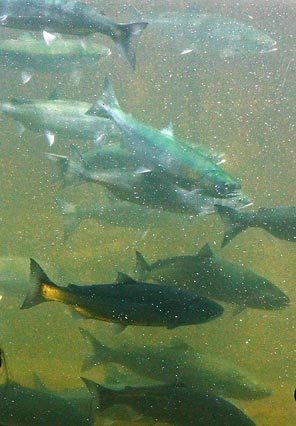forum
library
tutorial
contact

First Sockeye of the Year
Ends its Epic Trip to Stanley
by Rocky Barker
Idaho Statesman, July 26, 2008
|
the film forum library tutorial contact |

|
First Sockeye of the Year
by Rocky Barker
|
 The first sockeye salmon of the year returned to the Sawtooth Valley on Friday, and fisheries biologists are hoping hundreds more will follow.
The first sockeye salmon of the year returned to the Sawtooth Valley on Friday, and fisheries biologists are hoping hundreds more will follow.
So far, 814 sockeye have been counted at Lower Granite Dam near Lewiston and are heading for Redfish Lake and the Sawtooth Hatchery near Stanley.
Last year at this time, only 52 sockeye had crossed Lower Granite, and four eventually returned to the Sawtooth Valley.
The run of sockeye swimming up the Columbia and Snake rivers is the largest since 1955 and almost 10 times greater than last year.
Oregon officials and the Fish Passage Center, a team of biologists who monitor salmon migrations, say court-ordered spills of water over the eight dams that stand between Idaho and the Pacific Ocean account for the high returns. But federal officials say good ocean conditions are responsible.
The number of returning sockeye is higher than in any year since Lower Granite, the last dam built, opened in 1975. More than 213,400 sockeye have passed Bonneville Dam, the dam on the Columbia River closest to the ocean.
Paul Kline, assistant fisheries bureau chief for the Idaho Department of Fish and Game, said biologists are watching to see how many sockeye make the 462-mile trip from Lower Granite to the Sawtooth Valley.
The mortality rate from the Lower Granite has been as high as 75 percent in past years, partly because of high stream temperatures and a widespread parasite, Kline said.
The Fish Passage Center said in a memo a week ago that high water and artificial spills - water diverted from the hydroelectric turbines to the spillways - in 2006 and 2007 over the eight dams are one of the factors in greater fish survival. The other is that in those two years, fewer sockeye were placed in barges used to carry salmon past the dams, which allowed more power production.
"The fish are telling us something as to what set of conditions works for them," Michele DeHart, the center's manager, told The Oregonian newspaper. "Sockeye like a lot of flow, and they like spill."
If the Fish Passage Center is right, the two things that helped sockeye the most are costly to Pacific Northwest electricity customers because they lead to reduced power production. The conclusion also challenges federal biologists.
"I think most fishery scientists are of the mind that the primary influence is the ocean," Brian Gorman, a spokesman for the National Marine Fisheries Service, told The Oregonian. "It's going to require some thoughtful analysis, rather than a knee-jerk reaction."
U.S. District Judge James Redden ordered more spill for fish in late 2005 after he rejected the federal government's fifth plan for salmon and dams since 1992. The federal government has submitted a new plan that already has been challenged.
Oregon officials said in a brief filed Tuesday that Redden should reject the latest plan and force additional measures to save the fish. The plan relies entirely on hatchery operations to maintain the Snake River sockeye population, yet acknowledges that these sockeye are at a high risk of extinction and hatchery domestication, Oregon attorneys wrote.
That means the sockeye may be losing their genetic diversity and ability to survive in the wild despite rising numbers.
The Fisheries Service calls the absence of a functional natural population the greatest limiting factor to sockeye. But the plan calls for barging salmon to the Pacific and stopping all artificial spills from May 7- 20. Federal scientists say this has been proven to help other endangered salmon.
Research shows that sockeye, the salmon least able to tolerate handling, don't benefit from barging. They benefit from shorter travel times, which come from spilling water over the dams to speed flows, Oregon attorneys wrote.
Sockeye were listed as an endangered species in 1991, the first of 13 salmon and steelhead species to be protected under the Endangered Species Act in the Pacific Northwest.
"We need sustained increases in sockeye returns over several years before we break out the good champagne and declare a positive trend," said Amanda Peacher, salmon program coordinator for Idaho Rivers United.
learn more on topics covered in the film
see the video
read the script
learn the songs
discussion forum
